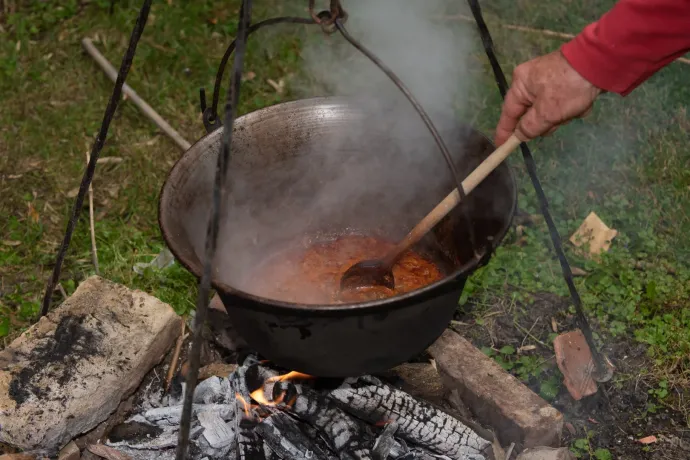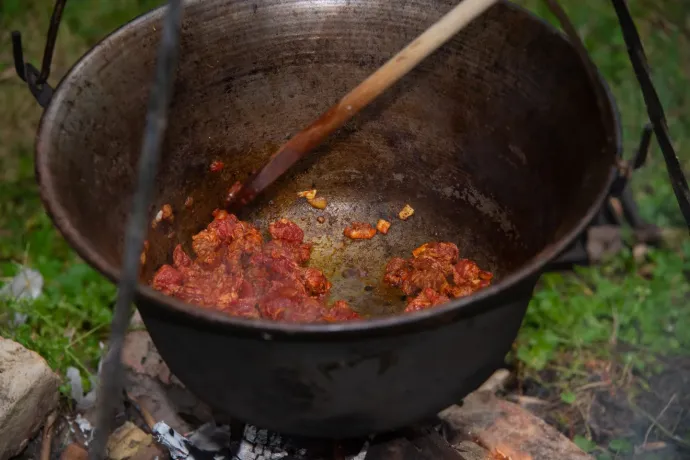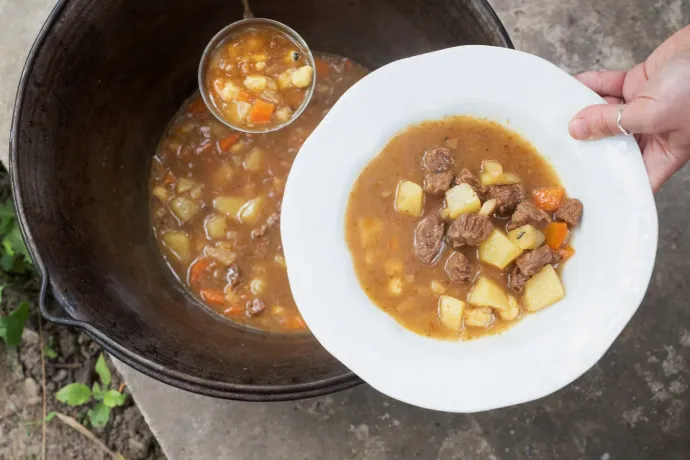
Summertime is here, and outdoor goulash cooking is in season. Since spring, flushed party hosts have been stirring away at their cauldron over the fire at the heart of their garden party. All around them, their guests, spritzers and beers in hand, can’t resist offering their own opinions to the chef about the right way to make goulash. Some will say the fire needs more wood, others that red wine needs to be added, that the pepper should be chopped into squares or that the goulash needs more water. Heated debates will break out around the fire over such vital questions as what size pieces to chop the meat into and when to add the potatoes, as well as philosophical dilemmas over the raison d’être of the noodle.
The host usually relies on their own, totally secret recipe and cauldron approach, which might consist of nothing more than a tube of goulash paste. The ceremony surrounding goulash is rooted in the ancient communal act of gathering round the fire — that’s no great mystery. All the chatter and the compulsion for debate may be a more recent addition, but they are a regular feature of any communal cooking ritual in Hungary.
Goulash was officially declared a “Hungarikum” in 2017, placed on the hallowed list of national treasures set up by Viktor Orbán to preserve Hungary’s cultural heritage. It is a part of our national identity, and a key tourist attraction on restaurant menus. However, most experts would agree that it is incredibly hard to get a good goulash in a restaurant. If we read through the nomination for goulash as a Hungarikum, it is clear that we are talking about a traditional — indeed, ancient — Hungarian dish.
It is also apparent that an extraordinary number of ingredients have gone into the recipe for goulash which, according to the real history of this not very old dish, have no place in it: vegetables, garlic, caraway seeds and so forth. Foreigners certainly struggle with the definition of goulash. In Austrian cuisine gulasch is more of a stew, and this became the internationally accepted form — viz. British goulash — in which you find vegetables, spices and all sorts of things. Of course to us Hungarians, gulyás is a soup. However, even we seem confused when it comes to defining our national dish.
Was this really what the herdsmen of old ate?
The national cauldron culture raises many disquieting questions. Why is it so important for Hungarians? And since when? If gulyás is the prototypical soup made in a cauldron, is it really the oldest dish we have? And did the old herdsmen on the Hungarian plains — gulyás — have anything to do with it?
The truth behind the old myths was exposed in writer István Váncsa’s first cookery book. He showed that social historian Ferenc Erdei’s story about how the gulyás cooked gulyás out on the plains was based on a completely false premise.
In his Ethnographic Gourmet Mastery, Erdei wrote that the herdsmen put everything in the cauldron — meat, onion and water — and lit the fire. Váncsa pulls the whole idea apart. The herdsmen couldn’t have bought beef as they didn’t have fridges or freezers on the plain, and in the countryside there was neither beef nor butcher, really. Even if there had been, herdsmen wouldn’t have been able to afford it. As for the idea that the herdsmen were putting herds of cattle out to pasture so had plenty of meat available, Váncsa points out their job was to graze animals, not to eat them.

Nonetheless, the cauldron, as a culinary implement, has been around for a long time. When I asked Váncsa about this, he said:
“Its roots lie in Inner Asia, where the Hungarian tribes came from. As for what those tribes might have put in their cauldrons, the answer’s pretty obvious. What did the nomads grazing cattle, sheep and goats have? Milk, so it was most probably milk products that they would have assembled in their pot — which is exactly what the inhabitants of Inner Asia do to this very day. Their word for cauldron is kazán, which is the same as the Hungarian word for furnace."
It’s hardly surprising that the cauldron — quazan — holds an important place in Kyrgyz, Turkish, Azeri, Uyghur and related cuisines. They used their pots not only for soups (shoba, shorva and other similarly named dishes, which are related to the Transylanian csorba) and stews, but also for frying dough in oil and for rice dishes — plov or pilaf. This brings to mind the Spanish paella, cooked in a pan over an open fire. If we go further into the far side of Asia, we reach the ovens of India, in which they cook that fabled spicy, tender meat, and beyond that are the far-eastern woks. Woks are very different kettles of fish: here, attention is paid to textures and vitamins — we’ve come a long way from Hungarian goulash, where everything is cooked to destruction.
Now, hot metal is a remarkable thing: it offers an even, constant heat, but you can achieve that on a gas ring with a normal saucepan. So your cauldron over an open fire is pure romanticism, a community experience, a rite that goes back to man’s most ancient assembly tendencies. Váncsa reckons cooking over an open fire may not contribute anything of value to the food itself, but spiritually it is very important.
“In terms of cooking technique a cauldron over a fire doesn’t offer anything more in terms of flavour than a pan on a stove. However, cooking round an open fire, the spectacle of the flames, the smell of the smoke, the restorative effects of the copious amounts of wine, beer and brandy, the mosquitoes and all the other extras that are part of this ritual all serve to create an atmosphere which renders that simple gastronomic experience itself richer and more complex.”
So what did the ancient Hungarians cook in their pots?
Váncsa makes an important point in his first book when he says that Hungarian cuisine is pot-based, not oven-based.
Hungarians don’t incinerate their food but burn it onto the sides of their cauldron.
We don’t grill or bake, we cook in a pan, and that’s the way it has always been.

Exactly what was in these pans in olden times is the source of much debate. It could well be that meat was cooked in them, but not exactly in the way that is commonly believed.
I asked Váncsa about this:
“In a place with a lot of animals there would also have been injured and sick animals, which naturally would be slaughtered and cooked. So they would have cooked cow, sheep, even horse meat or whatever animal of theirs they slaughtered. But the idea that herdsmen tending other people’s livestock would cook up their master’s animals is clearly ridiculous, a totally naïve concept.”
One hypothesis is that the earliest traceable foods cooked in cauldrons were porridges. These kinds of foods would once have formed the basis of people’s nourishment and would have been made not just with cereals but also with pasta — and later with potatoes. Anthropological research suggests that on the Hungarian Great Plain porridges were the oldest cauldron food, dishes such as slambuc. This is a pasta porridge that is fried and constantly stirred. It is made with noodles and potatoes — though the latter is a later addition, as it would originally have been made with grated or chopped pasta.
So how did goulash come about?
Goulash and stew — pörkölt — recipes began to appear occasionally in cookbooks in the 19th century but this appears to have been a conscious decision. The Hungarian nobility was trying to build up the national image by highlighting famed Hungarian dishes. This forging of a tradition led to the writing of a cookbook popularising potatoes during a wheat shortage to get the populace to eat potatoes.
It was in such a book that the very first goulash recipe appears, a stew-precursor without paprika but with potatoes. The basic technique of stews — chopping up meat and frying or braising it with this and that, with or without spices, or just in its own juices — can be found back in the 17th century.
Later, mainly in the region of Transylvania, these basic stews made without paprika were called tokány. In a sense this tokány kind of stew was the grandfather of the modern Hungarian stew, the pörkölt. However, at this point we should refer back to an essay, again by István Váncsa, that unexpectedly crops up in his French cookbook Lakoma, and has some relevance here.
He writes that every people has their own version of tokány, from the Romanian tocana, the Greek stofadó and the Spanish estofado to the Italina spezzatino, the French boeuf bourguignon and the Indian, Indonesian and other kinds of curries.

We could define it by saying we cut the meat into strips rather than cubes, but that is more a matter of habit. The writer’s alter ego, Mr Wildschwein, reaches the conclusion that a tokány is any ragout prepared within the Austro-Hungarian Monarchy that differs from a pörkölt. The point of the story is that Annabella, the heroine, is making a French goulash, called boeuf á la gardiane, in a casserole dish. This is a refined version of a Hungarian goulash made with marinated meat and cooked in a flambéed spicy sauce with olives and red wine.
Is there a recipe for goulash?
Written recipes for goulash soups for a long time resembled a pörkölt stew with potatoes added. Even at the end of the 19th century in Ágnes Zihály’s cookbook potatoes were the only vegetable to go into goulash. A little later, Károly Gundel also defined goulash as a pörkölt with potatoes, although he also put small noodles in.
Goulash soup does not feature in the most important cookbooks in the Hungarian regions in the 19th century, such as that of Rézi néni or the cookbook of the Hungarian plains. The gourmet Elek Magyar, writing in the 1930s, uses various technical means to differentiate goulash from pörkölt in his cookbook. He says that in a goulash there should be less onion, the sauce should not be sweet and it should have different kinds of meat — such as knuckle and offal – so that the sauce is more fatty and gelatinous. There’s no harm, he believed, in using meat from different animals, although beef keeps its flavour best over long cooking.
If we move on to the 1950s and Mrs Ferenc Móra’s magnificent recipe collection, we find that goulash is still a pörkölt with potatoes and noodles. It’s no surprise that among the well-known cookbooks Ilona Horváth is the first to put other vegetables into the recipe, which is an important change. The addition of carrots, celeriac and parsley roots takes the flavour in a totally different direction. This goulash is becoming more like other soups, and is getting further away from a pörkölt stew.
Goulash, as you like it.
It makes no difference how your initial stew is made – what kinds of meat you use and which cuts, how much onion or lard and whether you use bacon. The variations on what goes in after that are also endless. The versions with vegetables range from the root vegetables listed above to [those that include] kohlrabi, cabbage, beans, pickled cabbage and noodles. The addition of hot paprika, garlic, caraway seeds and thyme cause further debate, as do adding a tube of goulash paste or a stew stock.

Reforming goulash
A good ten years ago, a gastronomic revolution seemed to be in the air in Hungary. Chefs and gastro festivals sought to renew, perfect or simply fully grasp a dish that is incredibly hard to define. Tamás Széll entered the 2012 Bocuse d’Or, the international chef competition, with a complex goulash soup. He broke it down into its elements and separately prepared the meat, vegetables and different stocks.
A year later goulash was the theme of the Budapest Gourmet Festival, one of the biggest gastronomic events in Hungary, where the country’s top restaurants tried to define the national dish using such tricks as throwing a cork in the soup, giving out the goulash as an ice cream or making it with game or mutton. There were even Far Eastern goulash fusions, for example a Thai-goulash. What’s interesting here is that, in spite of the endeavours of the cream of Hungary’s cooks, there is no accepted definition of a goulash soup.
Goulash is whatever we make to please our friends and family: a pörkölt stew with all kinds of everything. That everything might be soup vegetables, spices, potatoes, noodles — it’s all down to what the person sweating over the pot and all the interfering bystanders who can’t resist saying their bit decide. One reason why this dish cannot be defined is that when we write it down, it loses its malleability, that special something we learnt from our forebears, that possibility that we’ll cook a bit of ourselves into it.
My favourite goulash is the one shown in the photos here, which is my father’s. It might be prepared in the same way as the reader’s goulash, or the reader’s father’s goulash. If I was cooking one myself, I might make the Camargue goulash Váncsa wrote about in his book Francia Lakoma (The French Feast). Or perhaps the goulash prepared by the father of the writer György Dragomán, made with a special soy sauce and ginger goulash paste for an Asian touch.
Translation: Charles Hebbert
If you want to make sure not to miss similar content from Telex English in the future, subscribe to our newsletter!
The translation of this article was made possible by our cooperation with the Heinrich Böll Foundation.